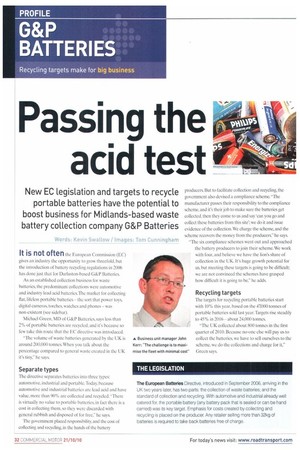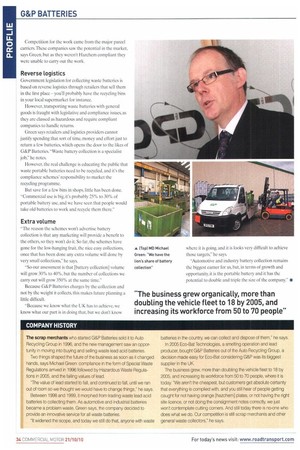Passing the acid test
Page 32

Page 34

If you've noticed an error in this article please click here to report it so we can fix it.
New EC legislation and targets to recycle portable batteries have the potential to boost business for Midlands-based waste battery collection company G&P Batteries
Words: Kevin Swallow / Images: Tom Cunningham
It is not often the European Commission (EC) gives an industry the opportunity to grow threefold, but the introduction of battery recycling regulations in 2006 has done just that for Darlaston-based G&P Batteries.
As an established collection business for waste batteries, the predominant collections were automotive and industry lead acid batteries. The market for collecting flat, lifeless portable batteries — the sort that power toys, digital cameras, torches, watches and phones — was non-existent (see sidebar).
Michael Green, MD of G&P Batteries, says less than 2% of portable batteries are recycled, and it's because so few take this route that the EC directive was introduced.
"The volume of waste batteries generated by the UK is Business unit manager John around 200,000 tonnes. When you talk about the Kerr: "The challenge is to maxi percentage compared to general waste created in the UK mise the fleet with minimal cost" it's tiny," he says.
Separate types
The directive separates batteries into three types: automotive, industrial and portable. Today, because automotive and industrial batteries are lead acid and have value, more than 90% are collected and recycled. -There is virtually no value to portable batteries, in fact there is a cost in collecting them, so they were discarded with general rubbish and disposed of for free," he says.
The government placed responsibility, and the cost of collecting and recycling, in the hands of the batteiy producers. But to facilitate collection and recycling, the government also devised a compliance scheme. "The manufacturer passes their responsibility to the compliance scheme, and it's their job to make sure the batteries get collected, then they come to us and say can you go and collect these batteries from this site': we do it and issue evidence of the collection. We charge the scheme, and the scheme recovers the money from the producers." he says.
"The six compliance schemes went out and approached the battery producers to join their scheme. We work with four, and believe we have the lion's share of collection in the UK. It's huge growth potential for us. but meeting these targets is going to be difficult; we are not convinced the schemes have grasped how difficult it is going to be," he adds.
Recycling targets The targets for recycling portable batteries start with 10% this year, based on the 47,000 tonnes of portable batteries sold last year. Targets rise steadily to 45% in 2016 — about 24,000 tonnes.
"The UK collected about 800 tonnes in the first quarter of 2010. Because no-one else will pay us to collect the batteries, we have to sell ourselves to the scheme, we do the collections and charge for it," Green says. Competition for the work came from the major parcel carriers. These companies saw the potential in the market, says Green, but as they weren't Hazchem compliant they were unable to carry out the work.
Reverse logistics
Government legislation for collecting waste batteries is based on reverse logistics through retailers that sell them in the first place — you'll probably have the recycling bins in your local supermarket for instance.
However, transporting waste batteries with general goods is fraught with legislative and compliance issues, as they are classed as hazardous and require compliant companies to handle returns.
Green says retailers and logistics providers cannot justify spending that sort of time, money and effort just to return a few batteries, which opens the door to the likes of G&P Batteries. "Waste battery collection is a specialist job," he notes.
However, the real challenge is educating the public that waste portable batteries need to be recycled, and it's the compliance schemes' responsibility to market the recycling programme.
But save for a few bins in shops, little has been done. "Commercial use is big, it's probably 25% to 30% of portable battery use, and we have seen that people would take old batteries to work and recycle them there."
Extra voLume
The reason the schemes won't advertise battery collection is that any marketing will provide a benefit to the others, so they won't do it. So far, the schemes have gone for the low-hanging fruit, the nice easy collections, once that has been done any extra volume will done by very small collections," he says.
"So our assessment is that [battery collection] volume will grow 30% to 40%, but the number of collections we carry out will grow 350% at the same time."
Because G&P Batteries charges by the collection and not by the weight it collects, this makes future planning a little difficult.
"Because we know what the UK has to achieve, we know what our part is in doing that, but we don't know where it is going, and it is looks very difficult to achieve those targets," he says.
"Automotive and industry battery collection remains the biggest earner for us, but, in terms of growth and opportunity, it is the portable battery and it has the potential to double and triple the size of the company.•




























































































































